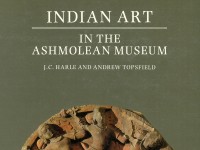Indian Art in the Ashmolean Museum
A catalogue of the Ashmolean’s collection of Indian art by J. C. Harle and Andrew Topsfield (published Oxford, 1987).

Publications online: 143 objects
- Reference URL
Actions
Standing figure of Vishnu
-
Literature notes
This fine stele represents the god Viṣṇu, easily identifiable by his tall cylindrical crown (kirīṭa-mukuṭa) and the discus and conch held in his rear hands. The large size of these emblems and the small flames sprouting from them, as well as the discus turned endwise, are all stylistic marks of the end of the Pallava period (7th–9th centuries), as is the little strip of material sticking up from the topmost belt. The outline of the stele follows that of the figure.
The god stands stiff-legged and wears an ankle-length transversely pleated dhoti, the man’s lower garment still worn by vast numbers of Indians today. There are three belts, the upper apparently jeweled and the lower (presumably of cloth) having outward-flowing side-ribbons and an ankle-length pleated strip hanging down on each side. The god wears a sacred thread (yajñopavīta) and stomach band (udurabandha); the former has a clasp by the shoulder and one strand joins the stomach band. Jewellry includes triangular foliate ear-rings, armlets (keyūras) with a central circular portion from which rise three jeweled spikes, a single broad necklace and three plain bracelets on each wrist.
Monuments and sculpture in stone only appear in Tamilnadu in the 7th century, although their degree of stylistic development implies a previous tradition in perishable materials. Images of this type, both cut out of the living rock or in high relief on stele, thus stand fairly close to the emergence of the style which was to be continued so brilliantly under the early Coḷas. Due to its late appearance and the intense conservatism of sculptural style in South India (indeed through the whole Coḷa period that ends c.1250 A.D., there are no radical departures), the history of style in Tamilnadu follows a very different rhythm from that in other parts of India. -
Details
- Associated place
-
Asia › India › south India › Tamil Nadu (place of creation)
- Date
-
7th - 9th century AD (AD 601 - 900)
Pallava Period (AD 600 - 750)
- Material and technique
- granite
- Dimensions
-
with mount 106 x 49 x 28 cm max. (height x width x depth)
91 x 41 x 19 cm max. (height x width x depth)
mount 15 x 37 x 28 cm (height x width x depth)
- Material index
- Technique index
- Object type index
- No. of items
- 1
- Credit line
- Purchased, 1981.
- Accession no.
- EA1981.10
-
Further reading
Harle, J. C., and Andrew Topsfield, Indian Art in the Ashmolean Museum (Oxford: Ashmolean Museum, 1987), no. 65 on p. 54, illus. p. 54
Glossary
Vishnu
-
Vishnu
Vishnu is, with Shiva, one of the two most important gods in later Hinduism. He is regarded as sustainer of the universe and maintainer of order. Assuming various forms (avatars), he restores the balance of good and evil in the world.
Location
Objects are sometimes moved to a different location. Our object location data is usually updated on a monthly basis. Contact the Jameel Study Centre if you are planning to visit the museum to see a particular object on display, or would like to arrange an appointment to see an object in our reserve collections.
Publications online
-

Indian Art in the Ashmolean Museum
This fine stele represents the god Viṣṇu, easily identifiable by his tall cylindrical crown (kirīṭa-mukuṭa) and the discus and conch held in his rear hands. The large size of these emblems and the small flames sprouting from them, as well as the discus turned endwise, are all stylistic marks of the end of the Pallava period (7th–9th centuries), as is the little strip of material sticking up from the topmost belt. The outline of the stele follows that of the figure.
The god stands stiff-legged and wears an ankle-length transversely pleated dhoti, the man’s lower garment still worn by vast numbers of Indians today. There are three belts, the upper apparently jeweled and the lower (presumably of cloth) having outward-flowing side-ribbons and an ankle-length pleated strip hanging down on each side. The god wears a sacred thread (yajñopavīta) and stomach band (udurabandha); the former has a clasp by the shoulder and one strand joins the stomach band. Jewellry includes triangular foliate ear-rings, armlets (keyūras) with a central circular portion from which rise three jeweled spikes, a single broad necklace and three plain bracelets on each wrist.
Monuments and sculpture in stone only appear in Tamilnadu in the 7th century, although their degree of stylistic development implies a previous tradition in perishable materials. Images of this type, both cut out of the living rock or in high relief on stele, thus stand fairly close to the emergence of the style which was to be continued so brilliantly under the early Coḷas. Due to its late appearance and the intense conservatism of sculptural style in South India (indeed through the whole Coḷa period that ends c.1250 A.D., there are no radical departures), the history of style in Tamilnadu follows a very different rhythm from that in other parts of India.
Galleries
Notice
Object information may not accurately reflect the actual contents of the original publication, since our online objects contain current information held in our collections database. Click on 'buy this publication' to purchase printed versions of our online publications, where available, or contact the Jameel Study Centre to arrange access to books on our collections that are now out of print.
© 2013 University of Oxford - Ashmolean Museum



